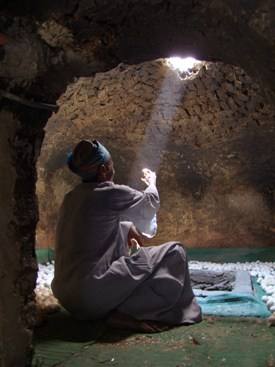Egyptians hatch eggs the traditional way

Having a hatchability of more than eighty percent during the winter without using electricity and fancy tools is no exception in prehistoric incubators. They can be found in caves or clay houses in Egypt’s dessert. Learn more about hatching eggs the traditional way.
By Wiebe van der Sluis
Those who believe that hatching eggs artificially is an invention of the 20thcentury are wrong. The first eggs hatched without the help of mother hen dates back at least till the Pharaoh’s time. During those days in ancient Egypt fertile eggs were collected and hatched in caves. Most of the time the hatchery manager was a man of high age who learned from his father how to control the incubation process. Generations after generations have transferred the technique so up till today we can learn how they managed to maximise chick output at the lowest possible cost.
When travelling through Egypt you still may find a number of these prehistoric hatcheries. One of them can be found in Fayum, a place which during the Roman times was known to be the breadbasket of Egypt. Cereals and cotton were and still are the main products. Besides crop production the oasis also received a reputation of being the ancient centre of poultry breeding. The Fayumi chicken breed is known for laying a high number of eggs no matter whether it was winter or summer. It is an early maturing bird with an impressive heat resistance.
Transfer over generations
Eggs from the Fayumi breeders were collected and hatched in specially designed caves or clay-houses. Heating is done by lighting a fire, natural heat from the sun or using oil lamps. Ventilation is totally naturally controlled by means of doors, curtains and a chimney at the top of each incubator cell.
| The drawing on the wall indicates the entrance of the ancient hatchery. | The central corridor allows the hatchery worker access to the incubator cells through small openings in the wall. | Each cell has two levels. This floor level provides space for at least 10,000 eggs. |
200,000 egg capacity
Every week the family sets 40,000 eggs and sells over 32,000 chicks. Most of these chicks are sold directly to farmers near Fayum, while the remaining chicks are sold through a middle man to producers all over Egypt. The fertile eggs are bought from a few breeder farms in Fayum and randomly set. At day 4 all eggs are candled. Traditionally this is done by using the beam of sun light which enters the hatchery cell through a small hole at the top. When there is no sun light a small box with an electric lamp is being used. The number of infertile eggs usually is no more than 10%.
| Egg candling using a box with a lamp when there is no sunlight available. | The egg temperature is measured by using the sensitivity of the eyelid. | Eggs are turned manually a few times per day. |













